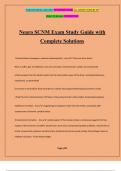©GRACEAMELIA 2024/2025 ACADEMIC YEAR. ALL RIGHTS RESERVED
FIRST PUBLISH OCTOBER 2024
Neuro SCNM Exam Study Guide with
Complete Solutions
Cerebral Edema (vasogenic, cytotoxic hydrocephalic) - Ans:✔✔-There are three kinds:
Brain is softer, gyri are flattened, sulci are narrowed, and ventricular cavities are compressed
a.fluid escapes from the blood vessels into the intercellular space of the brain. Localized (abscesses,
neoplasms), or generalized
b.increase in intracellular fluid secondary to cellular injury (generalized hypoxic/ischemic insult)
c.fluid from the intraventricular CSF flows to the periventricular white matter during hydrocephalus
Subfalcine hernation - Ans:✔✔-cingulate gyrus displaces under the falx cerebri, associated with
compression of anterior cerebral artery
Transtentorial hernation- - Ans:✔✔-medial aspect of the temporal lobe is compressed against the free
margin of the tentorium cerebelli. Oculomotor nerve (3) is compressed (pupillary dilation, impairment of
ocular movements), posterior cerebral artery (ischemia of primary visual cortex), hemorrhagic lesion in
midbrain and pons - Duret hemorrhages
Page 1/50
, ©GRACEAMELIA 2024/2025 ACADEMIC YEAR. ALL RIGHTS RESERVED
FIRST PUBLISH OCTOBER 2024
Tonsillar herniation - Ans:✔✔-displacement of cerebellar tonsils through the foramen magnum and
compression of medulla oblongata (death)
Hydrocephalus - Ans:✔✔-Accumulation of excessive CSF within the ventricular system of the brain d/t
decreased resorption of CSF, It results in a) dilation of ventricles and increase of intracranial pressure, b)
enlargement of head, if sutures are not closed, c) expansion of ventricles, if sutures are closed
frontal - Ans:✔✔-a fracture after loss of consciousness usually occurs here
occipital - Ans:✔✔-a fall while conscious usually occurs here fracture
Concussion - Ans:✔✔-alteration of consciousness secondary to head injury. Loss of consciousness,
temporary respiratory arrest, and loss of reflexes. Biochemical and physiologic abnormalities occur
(decreased ATP, depolarization of membranes)
frontal lobe, orbital gyri, temporal lobes - Ans:✔✔-Direct Parenchymal Injury when the head is immobile
occurs here
coup & contrecouup injury - Ans:✔✔-Direct Parenchymal Injury when the head is mobile results in these
two types of damages
contrecoup - Ans:✔✔-denoting an injury to the brain, occurring at a site opposite to the point of impact
Page 2/50
, ©GRACEAMELIA 2024/2025 ACADEMIC YEAR. ALL RIGHTS RESERVED
FIRST PUBLISH OCTOBER 2024
Diffuse Axonal Injury - Ans:✔✔-Mechanic forces damage the integrity of the axon in the Node of Ranvier
with alterations in axoplasmic flow. Axonal swellings and hemorrhage of the area. Coma shortly after
trauma
Epidural Hematoma - Ans:✔✔-laceration of middle meningeal artery, especially in fractures of the
temporal bone. Accumulation of blood separates dura from the skull. Clinically - pt is lucid for several
hours after trauma until neurologic signs develop.
Subdural hematoma - Ans:✔✔-displacement of brain that occurs in trauma can tear the veins at the
point where they penetrate the dura, because brain can move freely inside the skull while venous
sinuses are fixed
Clinically - begin within 48 h after trauma, located at the lateral aspects of the cerebral hemispheres.
Headache and confusion-
- lysis of the clot(1 week)
- organization of clot (2 weeks)
- hyalinized connective tissue firmly attached to dura but not in arachnoid (1-3 mo)
Post-traumatic hydrocephalus & dementia - Ans:✔✔-Sequelae of Brain Trauma
Global Cerebral Ischemia - Ans:✔✔-Cardiac arrest, shock, severe hypotension
In mild cases - transient post-ischemic confusional state, complete recovery, no tissue damage
Page 3/50
, ©GRACEAMELIA 2024/2025 ACADEMIC YEAR. ALL RIGHTS RESERVED
FIRST PUBLISH OCTOBER 2024
In severe cases - widespread brain infarction, pts. impaired neurologically and deeply comatose -
persistent vegetative state. Brain death - isoelectic \"flat\" EEG, MRI; brain stem damage (absent reflexes
and respiratory drive, absent perfusion). Autolysis of the brain.
Stroke (Focal Cerebral Ischemia) - Ans:✔✔-a sudden loss of consciousness resulting when the rupture or
occlusion of a blood vessel leads to oxygen lack in the brain d/t thrombosis, arteritis or embolism
Intracerebral Hemorrhage - Ans:✔✔-Spontaneous intraparenchymal hemorrhages occurs in individuals
over 60y associated with HTN, heart surgery, neoplasms
Subarachnoid Hemorrhage (Ruptured berry aneurysm) - Ans:✔✔-bleeding caused by a ruptured blood
vessel just outside the brain ) that rapidly fills the space between the brain and skull (subarachnoid
space) with blood; the patient may experience an intense, sudden headache accompanied by nausea,
vomiting, and neck pain. Associated with PKD and Marfan
AV Malformation - Ans:✔✔-a tangle of numerous, abnormally tortuous, misshapen vessels. Males, ages
10-30y
Clinically - seizure, intracerebral or subarachnoid hemorrhage in the territory of middle cerebral artery
Hypertensive Cerebrovascular Disease - Ans:✔✔-what has the eddect of hypertensive intercerebral
hemorrhage, lacunar infarct, slit hemorrhage, and hypertensive encephalopathy and it affects the deep
arterioles that supply the basal ganglia, white matter, brain stem makes the arteriolar wall get weaker w
chronic hypertension causes Charcot-Bouchard microaneurysms and can rupture
Page 4/50




